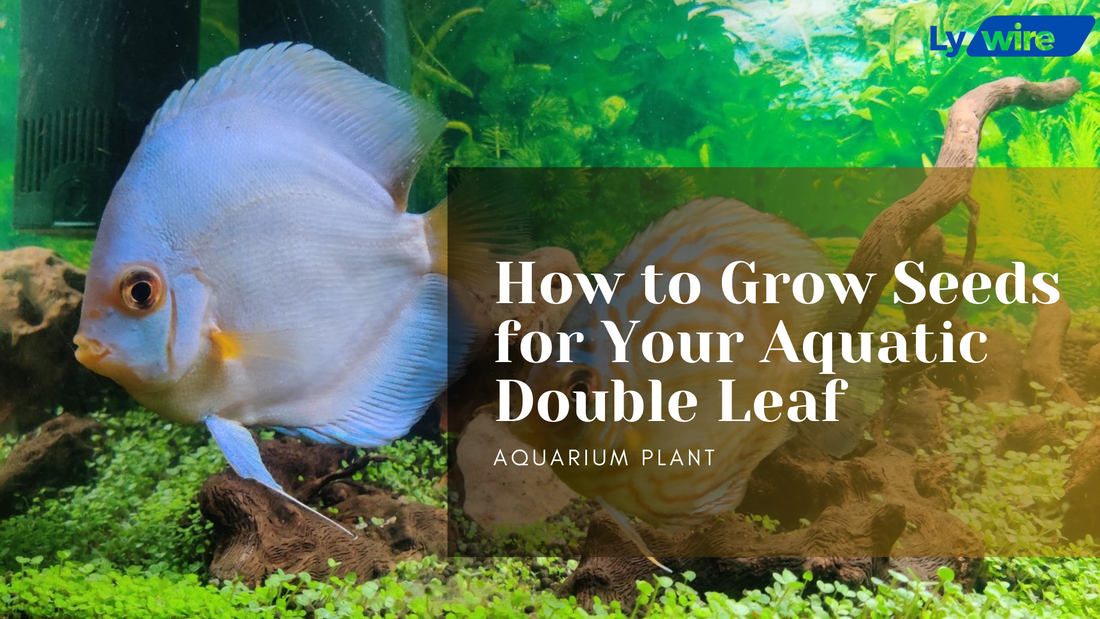Aquarium plants not only enhance the beauty of your tank but also contribute to a healthy ecosystem. Growing aquatic double-leaf plants from seeds requires careful attention to detail. This guide will walk you through the process step-by-step, ensuring optimal growth and propagation.
Understanding Aquatic Plant Propagation
Aquatic plants reproduce through two primary methods: sexual propagation (via seeds) and asexual propagation (via runners, offsets, or plantlets). For double-leaf aquarium plants, seed propagation is often the most viable option. However, it requires specific conditions for success. Understanding the unique needs of these plants is crucial for successful germination and growth.
Materials You’ll Need
Before starting, gather the following items:
- Seeds: Ensure they are specifically for aquatic plants. Double-leaf plants often have specific seed requirements, so sourcing high-quality seeds is essential.
- Aquatic soil/substrate: Options include Flourite, Eco-Complete, or ADA Amazonia. These substrates are rich in nutrients and provide a stable base for root development.
- Spray bottle: For maintaining moisture without disturbing the seeds.
- Plastic wrap or lid: To create a humid environment, which is crucial for seed germination.
- Plant light: Provide 10–12 hours of light daily. LED grow lights are ideal as they offer the right spectrum for plant growth without excessive heat.
- Thermometer: To monitor and maintain the optimal temperature for germination.
- Water conditioner: To ensure the water added during the transition phase is free from harmful chemicals.
:max_bytes(150000):strip_icc()/sumatra-barbs--blue-gourami--golden-barbs-1194278640-4844e7bb99d14b4fbe9c8302981c8350.jpg)
Step-by-Step Guide to Growing Seeds
1. Preparing the Substrate
Choose a nutrient-rich substrate like aquatic soil or sand. Spread the substrate evenly in your tank or container to a depth of about 1-2 inches. This depth allows for proper root development while ensuring the seeds remain close to the surface where they can receive light.
2. Planting the Seeds
Scatter the seeds evenly on top of the substrate. Avoid burying them as they need light to germinate. Lightly press the seeds into the substrate to ensure good contact, which helps with moisture absorption. Spray the seeds lightly with water until they are moist but not submerged. Overwatering can lead to seed rot, so it’s important to maintain a balance.
3. Creating a Humid Environment
Cover the tank with plastic wrap or a lid to trap humidity. This mimics the natural environment of aquatic plants and promotes germination. Ensure there’s some airflow by lifting the cover once daily for about 20 minutes. This prevents mold growth and allows fresh air to circulate.
4. Providing Light
Place a plant light above the tank and keep it on for 10–12 hours daily. LED grow lights are ideal as they provide the necessary light spectrum without generating excessive heat. Avoid direct sunlight as it can cause overheating and algae growth, which can compete with your seedlings for nutrients.

Caring for Germinating Seeds
Monitoring Moisture Levels
Check daily to ensure the substrate remains moist. If it starts drying out, spray lightly with water. Consistency is key; fluctuations in moisture levels can hinder germination. Using a spray bottle helps distribute water evenly without disturbing the seeds.
Temperature Control
Maintain a consistent temperature of around 25°C (77°F) to encourage germination. Use a thermometer to monitor the temperature and adjust as necessary. A small aquarium heater can be used if the room temperature is too low.
Transitioning to Submersion
Once seedlings sprout and grow a few leaves, it’s time to transition them to a fully aquatic environment. Gradually add water to the tank over several days. Start by adding a small amount of water, just enough to cover the substrate. Increase the water level gradually, allowing the plants to adjust. Ensure that seedlings remain submerged, but avoid sudden water level changes, which can stress the plants.

Tips for Success
Pollination for Seed Production
If propagating seeds from parent plants, ensure flowers grow above water for pollination. Use tools like a soft brush to transfer pollen between flowers. This mimics natural pollination processes and increases the chances of successful seed production.
Patience is Key
Germination can take several weeks; avoid disturbing the seeds during this time. It’s important to be patient and maintain consistent conditions. Rushing the process can lead to poor germination rates.
Prevent Algae Growth
Keep light exposure balanced and avoid over-fertilizing. Algae can compete with your seedlings for nutrients and light, so it’s important to manage these factors carefully. Regular water changes and the use of algae-eating fish or invertebrates can help keep algae under control.
Regular Maintenance
Once your plants are established, regular maintenance is essential. Trim dead or decaying leaves to promote healthy growth and prevent rot. Monitor water quality regularly, checking parameters like pH, ammonia, nitrite, and nitrate levels. Consistent water quality is crucial for the long-term health of your aquatic plants.
Growing aquatic double-leaf plants from seeds can be a rewarding experience when done correctly. By following these steps and maintaining optimal conditions, you’ll soon have vibrant plants thriving in your aquarium.
Not only will these plants enhance the aesthetic appeal of your tank, but they will also contribute to a balanced and healthy aquatic ecosystem. With patience, attention to detail, and regular care, you can enjoy the beauty and benefits of these unique plants for years to come.

